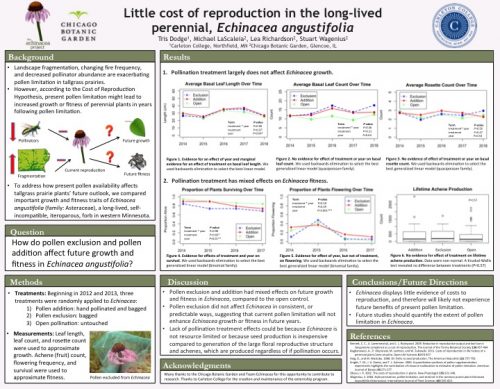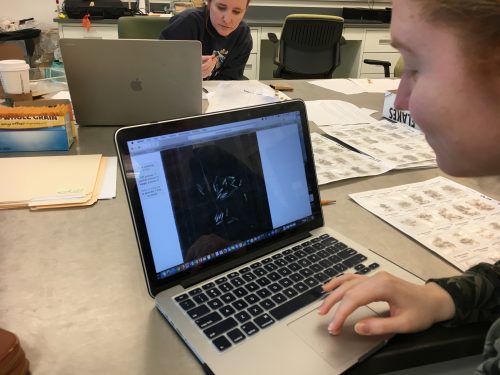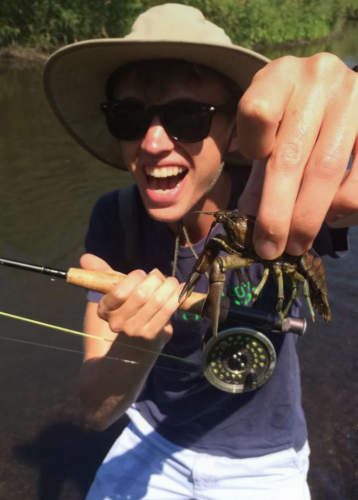|
|
Hi flog,
Wow! These last three weeks passed by super quickly! While the first two weeks were focused on seed cleaning, seed counting, and x-raying, we spent this past week on our independent projects. But that’s not to say this week was easy! In the past 5 days, I wrote exactly 900 lines of code in R to generate the figures and perform the analyses.
To get at how current pollen limitation affects Echinacea growth and future fitness, I performed analyses testing differences in plant traits between pollen exclusion, pollen addition, and open pollination treatments. I did not find evidence that pollination treatment affected either growth or fitness, which indicates that current pollen limitation will not benefit Echinacea in the future. This could be because Echinacea is not resource limited or because the cost of seed production is negligible.
Many thanks to the members of Team Echinacea who helped guide me through this process and made working in the lab such a pleasure!

Tris
Link to Poster
Hi flog,
Things have really gotten going, here at Echinacea headquarters. Julie, Sarah, Lea, and I have been spending much of our time cleaning and counting Solidago, and we’ve made pretty good headway, each counting about 2-3 samples per hour. We’ve also made some preliminary observations about variability. We’ve found high variability between plants, but not within plants! For example, we’ve seen ranges of 3 to 372 heads per stalk, and anything from 7 to 24 achenes per head in different plants. But within a plant, achenes per head is relatively uniform, generally ranging by ~2 achenes, which should allow Lea to precisely estimate total number of achenes per plant.
In addition to the Solidago, we’ve been working on Liatris. We finished the most important part of estimating potential reproductive success: x-raying the achenes to see if they contain seeds. This process involves placing baggies filled with Liatris achenes over a reusable x-ray film, shooting x-rays through the achenes, and quickly feeding the film through a machine that digitizes the film and allows for online counting of full and empty achenes. From this, we can estimate proportion of achenes containing seeds, multiply this proportion by number of achenes, and thus estimate reproductive potential of the plant. Because my project doesn’t involve seed set, Julie will be doing all the counting for Liatris (Fig. 1) while Sarah will handle counting for Solidago x-rays.
Until next time,
Tris

Fig. 1. Julie diligently counts full and empty Liatris achenes while Lea continues to count Solidago heads.
Dear flog,
My name is Tris Dodge and I am a winter research extern for the Echinacea Project. I am a senior biology major at Carleton College, interested in understanding how human-driven environmental change is affecting species interactions and causing rapid evolution. I spent the summer of 2017 in Carleton’s restored tallgrass prairies, researching how herbivore exclusion affects soil nutrients and community composition. Last summer, I was a research assistant for two projects at the Rocky Mountain Biological Laboratory (RMBL). I helped gather data on how changing phenology alters the competitive landscape and fitness of perennial wildflowers, and I monitored functional traits, fitness, and glucosinolate chemistry of Boechera stricta in a common garden, as part of a larger genome-wide association study. After graduating from Carleton, I hope to pursue a PhD in ecology or evolution. I enjoy spending my time outdoors and am a member of the cross country and track teams. In my free time, I hike, fly-fish, and knit.
This winter, I am a research extern assisting with projects testing pollen limitation in Echinacea angustifolia and how isolation in space and time affect fitness of Liatris aspera and Solidago speciosa. In practice, each day involves hours of cleaning and counting seeds while thinking about biology. So far, seed counting has allowed me to closely observe the beauty of flower physiology, and has also made me crave sunflower seeds (another Asteraceae). I am very excited to contribute to team Echinacea for these next few weeks!

|
|



